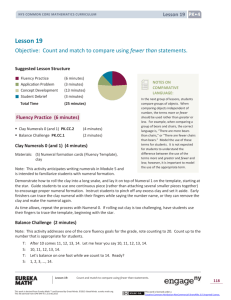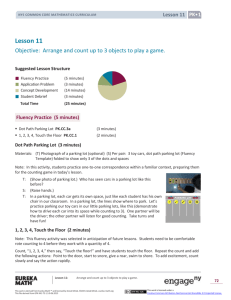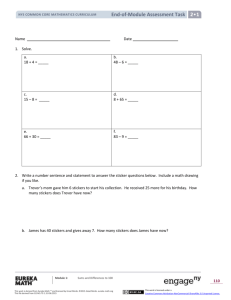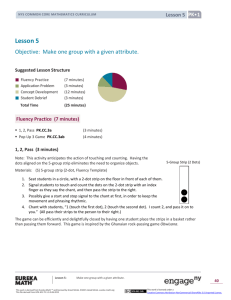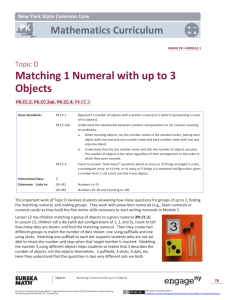End-of-Module Assessment
advertisement
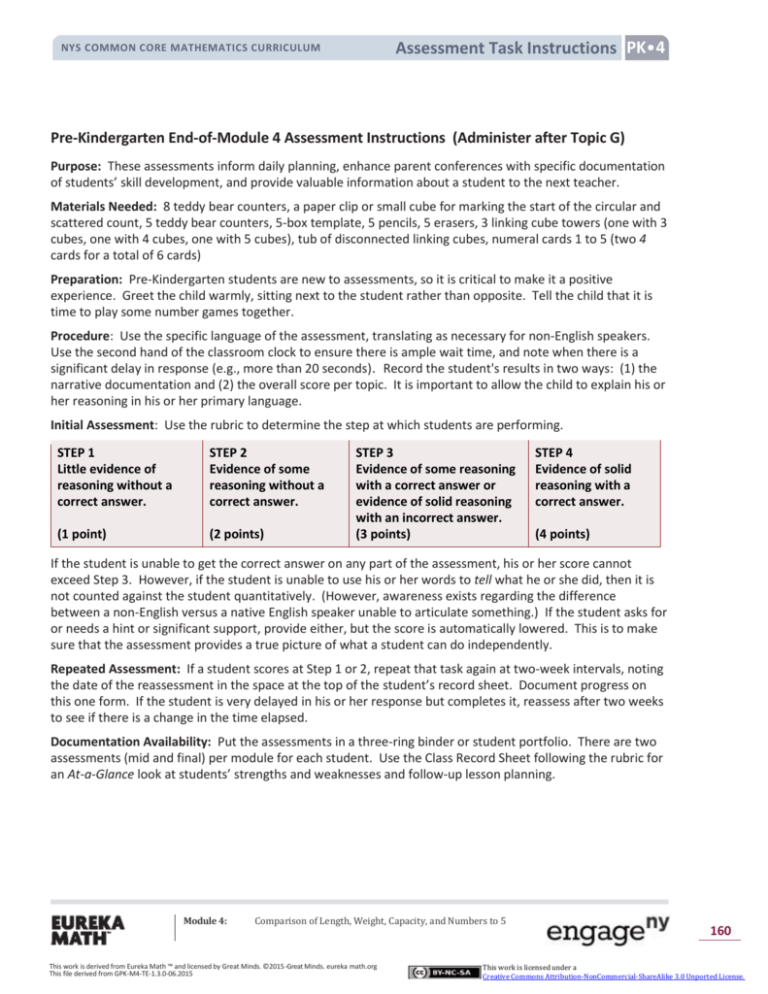
Assessment Task Instructions PK 4 NYS COMMON CORE MATHEMATICS CURRICULUM Pre-Kindergarten End-of-Module 4 Assessment Instructions (Administer after Topic G) Purpose: These assessments inform daily planning, enhance parent conferences with specific documentation of students’ skill development, and provide valuable information about a student to the next teacher. Materials Needed: 8 teddy bear counters, a paper clip or small cube for marking the start of the circular and scattered count, 5 teddy bear counters, 5-box template, 5 pencils, 5 erasers, 3 linking cube towers (one with 3 cubes, one with 4 cubes, one with 5 cubes), tub of disconnected linking cubes, numeral cards 1 to 5 (two 4 cards for a total of 6 cards) Preparation: Pre-Kindergarten students are new to assessments, so it is critical to make it a positive experience. Greet the child warmly, sitting next to the student rather than opposite. Tell the child that it is time to play some number games together. Procedure: Use the specific language of the assessment, translating as necessary for non-English speakers. Use the second hand of the classroom clock to ensure there is ample wait time, and note when there is a significant delay in response (e.g., more than 20 seconds). Record the student's results in two ways: (1) the narrative documentation and (2) the overall score per topic. It is important to allow the child to explain his or her reasoning in his or her primary language. Initial Assessment: Use the rubric to determine the step at which students are performing. STEP 1 Little evidence of reasoning without a correct answer. STEP 2 Evidence of some reasoning without a correct answer. (1 point) (2 points) STEP 3 Evidence of some reasoning with a correct answer or evidence of solid reasoning with an incorrect answer. (3 points) STEP 4 Evidence of solid reasoning with a correct answer. (4 points) If the student is unable to get the correct answer on any part of the assessment, his or her score cannot exceed Step 3. However, if the student is unable to use his or her words to tell what he or she did, then it is not counted against the student quantitatively. (However, awareness exists regarding the difference between a non-English versus a native English speaker unable to articulate something.) If the student asks for or needs a hint or significant support, provide either, but the score is automatically lowered. This is to make sure that the assessment provides a true picture of what a student can do independently. Repeated Assessment: If a student scores at Step 1 or 2, repeat that task again at two-week intervals, noting the date of the reassessment in the space at the top of the student’s record sheet. Document progress on this one form. If the student is very delayed in his or her response but completes it, reassess after two weeks to see if there is a change in the time elapsed. Documentation Availability: Put the assessments in a three-ring binder or student portfolio. There are two assessments (mid and final) per module for each student. Use the Class Record Sheet following the rubric for an At-a-Glance look at students’ strengths and weaknesses and follow-up lesson planning. Module 4: Comparison of Length, Weight, Capacity, and Numbers to 5 This work is derived from Eureka Math ™ and licensed by Great Minds. ©2015 -Great Minds. eureka math.org This file derived from GPK-M4-TE-1.3.0-06.2015 160 This work is licensed under a Creative Commons Attribution-NonCommercial-ShareAlike 3.0 Unported License. NYS COMMON CORE MATHEMATICS CURRICULUM End-of-Module Assessment Task PK 4 Student Name _________________________ Date 1 Topic D: First and Last Topic D Rubric Score ___________Time Elapsed ____________ Topic E Materials: (S) 8 teddy bear counters, a paper clip (or small cube) for marking the start of the circular count Topic F Date 2 Date 3 Topic G 1. (Place 5 teddy bear counters in a scattered configuration in front of the student.) Count the bears. When you are done, I’m going to ask you which bear you counted first and last. You can use this paper clip to help you remember which bear you counted first. (Pause.) Which bear did you count first? Which bear did you count last? 2. (Place 7 teddy bear counters in a linear configuration in front of the student.) The bears are in line waiting to go out of their classroom. Point to the last bear. Point to the first bear. (Turn all the bears around so that they are facing the opposite direction.) Now they are waiting in line to go back into their classroom. Point to the first bear. Point to the last bear. 3. (Place 8 teddy bear counters in a circular configuration. Have the paper clip readily accessible.) Count the bears. When you are done, I’m going to ask you which bear you counted first. You can use this paper clip to help you remember. (Pause.) Which bear did you count first? What did the student do? What did the student say? 1. 2. 3. Module 4: Comparison of Length, Weight, Capacity, and Numbers to 5 This work is derived from Eureka Math ™ and licensed by Great Minds. ©2015 -Great Minds. eureka math.org This file derived from GPK-M4-TE-1.3.0-06.2015 161 This work is licensed under a Creative Commons Attribution-NonCommercial-ShareAlike 3.0 Unported License. NYS COMMON CORE MATHEMATICS CURRICULUM End-of-Module Assessment Task PK 4 Topic E: Are There Enough? Rubric Score ___________Time Elapsed ____________ Materials: (S) 5 teddy bear counters, 5-box template 1. 2. (Place 3 teddy bear counters and the 5-box template in front of the student.) Match the bears to the boxes. Tell me if there are exactly enough boxes, enough boxes with some extras, or not enough boxes for the bears to sit on. (Place all of the teddy bear counters and the 5-box template in front of the student.) Match the bears to the boxes to show exactly enough boxes for the bears to sit on. What did the student do? What did the student say? 1. 2. Module 4: Comparison of Length, Weight, Capacity, and Numbers to 5 This work is derived from Eureka Math ™ and licensed by Great Minds. ©2015 -Great Minds. eureka math.org This file derived from GPK-M4-TE-1.3.0-06.2015 162 This work is licensed under a Creative Commons Attribution-NonCommercial-ShareAlike 3.0 Unported License. NYS COMMON CORE MATHEMATICS CURRICULUM End-of-Module Assessment Task PK 4 Topic F: Comparison of Sets Up to 5 Rubric Score ___________Time Elapsed ____________ Materials: (S) 5 pencils, 5 erasers 1. (Place 2 pencils and 4 erasers in front of the student.) Count the group of pencils and the group of erasers. (Pause.) Which group has more? 2. (Place 5 pencils and 4 erasers in front of the student.) Count the group of pencils and the group of erasers. (Pause.) Which group has less? 3. (Place 3 pencils and 5 erasers in front of the student. Have the other two pencils close by for students to use if desired.) Add pencils or take away erasers so that both groups have the same number of objects. What did the student do? What did the student say? 1. 2. 3. Module 4: Comparison of Length, Weight, Capacity, and Numbers to 5 This work is derived from Eureka Math ™ and licensed by Great Minds. ©2015 -Great Minds. eureka math.org This file derived from GPK-M4-TE-1.3.0-06.2015 163 This work is licensed under a Creative Commons Attribution-NonCommercial-ShareAlike 3.0 Unported License. NYS COMMON CORE MATHEMATICS CURRICULUM End-of-Module Assessment Task PK 4 Topic G: Comparison of Sets Including Numerals Up to 5 Rubric Score ___________Time Elapsed ____________ Materials: (T) Three linking cube towers (one with 3 cubes, one with 4 cubes, one with 5 cubes) (S) Tub of disconnected linking cubes, numeral cards 1 to 5 (two 4 cards for a total of 6 cards) 1. (Place the 5-tower and numeral cards in front of the student.) Count the cubes in this tower. (Pause.) Show me the number that matches the tower. (Move the chosen numeral next to the tower, and move aside.) 2. (Place the 3-tower in front of the student.) Count the cubes in this tower. (Pause.) Show me the number that matches this tower. (Move the chosen numeral next to the tower.) 3. (Move the 3-tower aside. Place the 5 and 3 numeral cards in front of the student.) Tell me about these numbers using more than, less than, or the same as. 4. (Remove all other materials, and place the tub of disconnected linking cubes, the 4-tower, and the 6 numeral cards in front of the student.) Show me the number that matches this tower (pointing to 4tower). Now, make a tower to match it. Show me the number that tells how many cubes are in this tower. Tell me about these numbers using greater than, less than, or the same as. What did the student do? What did the student say? 1. 2. 3. 4. Module 4: Comparison of Length, Weight, Capacity, and Numbers to 5 This work is derived from Eureka Math ™ and licensed by Great Minds. ©2015 -Great Minds. eureka math.org This file derived from GPK-M4-TE-1.3.0-06.2015 164 This work is licensed under a Creative Commons Attribution-NonCommercial-ShareAlike 3.0 Unported License. NYS COMMON CORE MATHEMATICS CURRICULUM End-of-Module Assessment Task PK 4 5-box template Module 4: Comparison of Length, Weight, Capacity, and Numbers to 5 This work is derived from Eureka Math ™ and licensed by Great Minds. ©2015 -Great Minds. eureka math.org This file derived from GPK-M4-TE-1.3.0-06.2015 165 This work is licensed under a Creative Commons Attribution-NonCommercial-ShareAlike 3.0 Unported License. NYS COMMON CORE MATHEMATICS CURRICULUM End-of-Module Assessment Task PK 4 End-of-Module Assessment Task Standards Addressed Topics D–G Compare Numbers. PK.CC.5 Identify whether the number of objects in one group is more, less, greater than, fewer, and/or equal to the number of objects in another group, e.g., by using matching and counting strategies. (1:1 up to 5 objects) PK.CC.6 Identify “first” and “last” related to order or position. Evaluating Student Learning Outcomes A Progression Toward Mastery is provided to describe and quantify steps that illuminate the gradually increasing understandings that students develop on their way to proficiency. In this chart, this progress is presented from left (Step 1) to right (Step 4). The learning goal for students is to achieve Step 4 mastery. These steps are meant to help teachers and students identify and celebrate what the students CAN do now and what they need to work on next. Module 4: Comparison of Length, Weight, Capacity, and Numbers to 5 This work is derived from Eureka Math ™ and licensed by Great Minds. ©2015 -Great Minds. eureka math.org This file derived from GPK-M4-TE-1.3.0-06.2015 166 This work is licensed under a Creative Commons Attribution-NonCommercial-ShareAlike 3.0 Unported License. NYS COMMON CORE MATHEMATICS CURRICULUM End-of-Module Assessment Task PK 4 A Progression Toward Mastery Assessment Task Item Topic D PK.CC.6 STEP 1 Little evidence of reasoning without a correct answer. STEP 2 Evidence of some reasoning without a correct answer. (1 point) (2 points) The student shows little evidence of understanding how to identify first and last. Student is confused and is unable to identify the first and last bear counted. The student shows evidence of beginning to understand how to identify first and last and is inconsistent in doing so. Student is uncertain of his or her identifications and looks to the teacher for confirmation. Student recounts the bears several times to try to figure out the first and last bear counted. STEP 3 Evidence of some reasoning with a correct answer or evidence of solid reasoning with an incorrect answer. (3 points) STEP 4 Evidence of solid reasoning with a correct answer. The student is able to do two of the following: The student correctly: Identifies the first and last bear in a scattered configuration, possibly using the paper clip or cube. Identifies the first and last bear in a linear configuration facing both directions (4 identifications total). Identifies the first bear in a circular configuration, possibly using the paper clip. Do not penalize the student for an incorrect count because this is not being assessed. Topic E PK.CC.5 The student shows little evidence of understanding how to show enough. Student is unable to match the bears to the boxes and clearly does not understand the correlation between the bears and the boxes in the context of enough. The student shows evidence of beginning to understand how to show enough. Teacher guides the student to match the bears to the boxes. The student is unable to begin the task independently. The student has difficulty using enough vocabulary. The student correctly does the following with more time elapsed for each task: Matches 3 bears to 3 boxes and states that there are enough boxes with some extra boxes. Matches 5 bears to 5 boxes to show there are exactly enough boxes for bears. Uses enough vocabulary (4 points) Identifies the first and last bear in a scattered configuration, possibly using the paper clip or cube. Identifies the first and last bear in a linear configuration facing both directions (4 identifications total). Identifies the first bear in a circular configuration, possibly using the paper clip. Do not penalize the student for an incorrect count because this is not being assessed. The student correctly: Matches 3 bears to 3 boxes and states that there are enough boxes with some extra boxes. Matches 5 bears to 5 boxes to show there are exactly enough boxes for bears. Uses enough vocabulary to talk about bears and boxes. to talk about bears and boxes. Module 4: Comparison of Length, Weight, Capacity, and Numbers to 5 This work is derived from Eureka Math ™ and licensed by Great Minds. ©2015 -Great Minds. eureka math.org This file derived from GPK-M4-TE-1.3.0-06.2015 167 This work is licensed under a Creative Commons Attribution-NonCommercial-ShareAlike 3.0 Unported License. NYS COMMON CORE MATHEMATICS CURRICULUM End-of-Module Assessment Task PK 4 A Progression Toward Mastery Topic F PK.CC.5 Topic G PK.CC.5 The student shows little evidence of understanding how to compare sets. The student clearly does not understand the correlation between the pencils and the erasers to make more than or less than comparison statements. The student is unable to manipulate the erasers and the pencils to make the groups equal. The student shows evidence of beginning to understand comparison of sets. Student inconsistently uses strategies, matching or counting, to make some correct comparison statements. The student shows little evidence of understanding how to compare sets including numerals. Student is unable to complete most of the tasks. Student is unclear on the relationship between the numbers and the sets. Student is unresponsive when asked to make comparison statements. The student shows evidence of beginning to understand how to compare sets including numerals. Student inconsistently uses strategies to make some correct comparison statements with the towers and numbers. Time elapsed for each task is prolonged. Module 4: The student looks to the teacher for confirmation of a correct response. The student is able to do two of the following: Counts the pencils and the erasers and makes a comparison statement that the eraser group has more. Counts the pencils and erasers and makes a comparison statement that the eraser group has less. Counts the pencils and the erasers and makes a comparison statement that the eraser group has more. Counts the pencils and the erasers and makes a comparison statement that the eraser group has less. Manipulates the erasers and pencils so that both groups are equal. Manipulates the erasers and pencils so that both groups are equal. Do not penalize the student for an incorrect count of the groups as long as his or her more or less statement is correct. Do not penalize the student for an incorrect count of the groups as long as his or her more or less statement is correct. The student is able to do two of the following: The student correctly: Chooses the correct numeral cards that correspond to each tower. Compares the numbers 3 and 5 with the towers nearby, but not directly next to, the numeral cards. Uses more than or less than in a comparison statement about 3 and 5. Makes a 4-tower out of disconnected linking cubes to match the 4tower placed in front of him. Places a 4 numeral card next to each tower and states something like, “The towers are the same.” Comparison of Length, Weight, Capacity, and Numbers to 5 This work is derived from Eureka Math ™ and licensed by Great Minds. ©2015 -Great Minds. eureka math.org This file derived from GPK-M4-TE-1.3.0-06.2015 The student correctly: Chooses the correct numeral cards that correspond to each tower. Compares the numbers 3 and 5 with the towers nearby, but not directly next to, the numeral cards. Uses more than or less than in a comparison statement about 3 and 5. Makes a 4-tower out of disconnected linking cubes to match the 4tower placed in front of him. Places a 4 numeral card next to each tower and states something like, “The towers are the same.” 168 This work is licensed under a Creative Commons Attribution-NonCommercial-ShareAlike 3.0 Unported License. NYS COMMON CORE MATHEMATICS CURRICULUM End-of-Module Assessment Task PK 4 Class Record Sheet of Rubric Scores: End-of-Module 4 Assessment Student Names Topic D: First and Last Module 4: Topic E: Are There Enough? Topic F: Comparison of Sets Up to 5 Topic G: Comparison of Sets Including Numerals Up to 5 Comparison of Length, Weight, Capacity, and Numbers to 5 This work is derived from Eureka Math ™ and licensed by Great Minds. ©2015 -Great Minds. eureka math.org This file derived from GPK-M4-TE-1.3.0-06.2015 Next Steps: 169 This work is licensed under a Creative Commons Attribution-NonCommercial-ShareAlike 3.0 Unported License.

